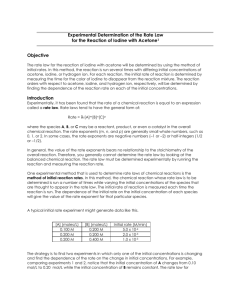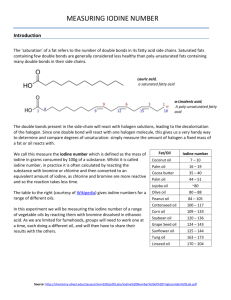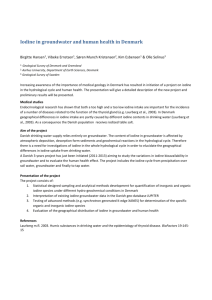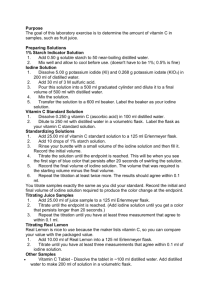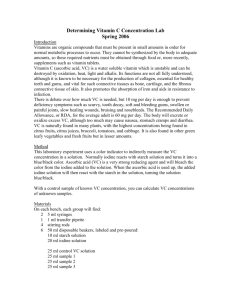Kinetics Lab - richsingiser.com
advertisement
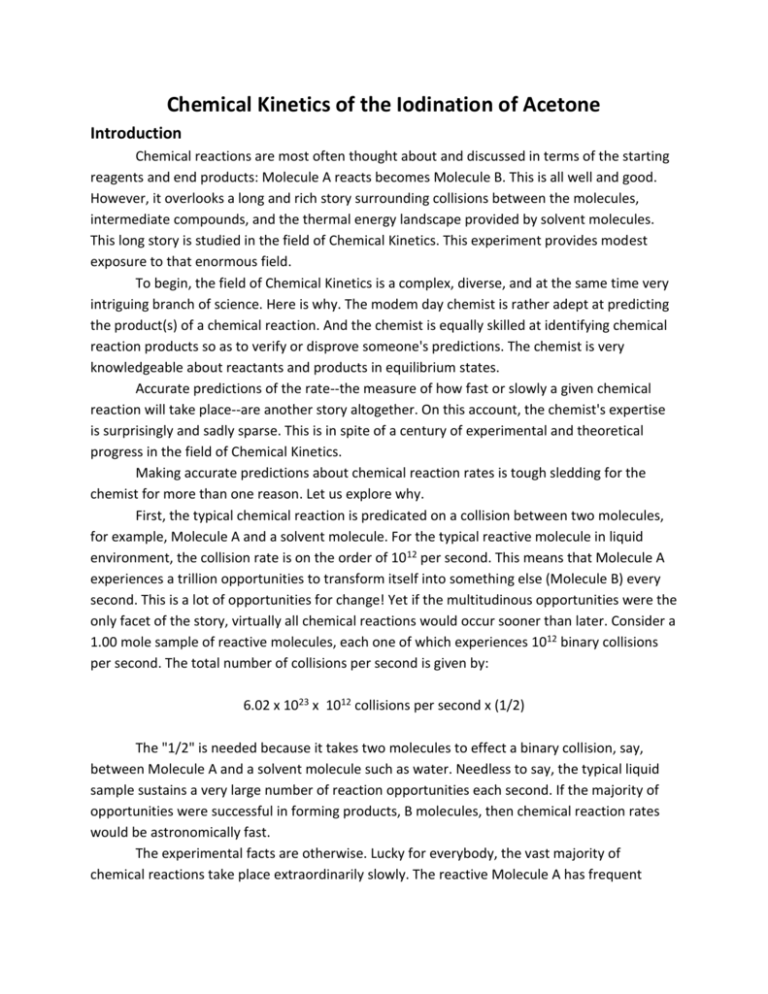
Chemical Kinetics of the Iodination of Acetone
Introduction
Chemical reactions are most often thought about and discussed in terms of the starting
reagents and end products: Molecule A reacts becomes Molecule B. This is all well and good.
However, it overlooks a long and rich story surrounding collisions between the molecules,
intermediate compounds, and the thermal energy landscape provided by solvent molecules.
This long story is studied in the field of Chemical Kinetics. This experiment provides modest
exposure to that enormous field.
To begin, the field of Chemical Kinetics is a complex, diverse, and at the same time very
intriguing branch of science. Here is why. The modem day chemist is rather adept at predicting
the product(s) of a chemical reaction. And the chemist is equally skilled at identifying chemical
reaction products so as to verify or disprove someone's predictions. The chemist is very
knowledgeable about reactants and products in equilibrium states.
Accurate predictions of the rate--the measure of how fast or slowly a given chemical
reaction will take place--are another story altogether. On this account, the chemist's expertise
is surprisingly and sadly sparse. This is in spite of a century of experimental and theoretical
progress in the field of Chemical Kinetics.
Making accurate predictions about chemical reaction rates is tough sledding for the
chemist for more than one reason. Let us explore why.
First, the typical chemical reaction is predicated on a collision between two molecules,
for example, Molecule A and a solvent molecule. For the typical reactive molecule in liquid
environment, the collision rate is on the order of 1012 per second. This means that Molecule A
experiences a trillion opportunities to transform itself into something else (Molecule B) every
second. This is a lot of opportunities for change! Yet if the multitudinous opportunities were the
only facet of the story, virtually all chemical reactions would occur sooner than later. Consider a
1.00 mole sample of reactive molecules, each one of which experiences 1012 binary collisions
per second. The total number of collisions per second is given by:
6.02 x 1023 x 1012 collisions per second x (1/2)
The "1/2" is needed because it takes two molecules to effect a binary collision, say,
between Molecule A and a solvent molecule such as water. Needless to say, the typical liquid
sample sustains a very large number of reaction opportunities each second. If the majority of
opportunities were successful in forming products, B molecules, then chemical reaction rates
would be astronomically fast.
The experimental facts are otherwise. Lucky for everybody, the vast majority of
chemical reactions take place extraordinarily slowly. The reactive Molecule A has frequent
opportunities to change itself into Molecule B. But the overwhelming majority of opportunities
prove unsuccessful. The molecule collides frequently, but with no chemical side effects.
Why do the vast majority of collisions result in no reaction? The oversimplified answer is
because (lucky for the chemist) the vast majority of molecules are inherently stable objects.
The chemical bonds which hold the atoms in Molecule A together are typically energy of 100
kilojoules per mole. By contrast, the typical collision energy is only about 3 kilojoules per mole.
Accordingly, the collision energy is insufficient for causing a "crack" in one or more of Molecule
A's chemical bonds. If such a crack would ever take place, then Molecule A would become very
reactive instantly, as the octet rule (among other things) is no longer satisfied.
Chemical reactions are predicated on collisions; hence no collisions, no reactions. But
the collisions that can result in reactions are rare events. How rare? Very occasionally a violent
collision takes place involving Molecule A with energy approaching that of one or more
chemical bonds. The collision energy is then absorbed by all parties, but in such a way that
causes a chemical bond in Molecule A to fracture. To be more quantitative, if the fracture
energy, the time-honored name is the activation energy E, is 100 kilojoules per mole, and
Molecule A's collision rate is 10 12 per second, then the number of collisions per second that
actually give birth to Molecule B at room temperature are approximately:
−𝐸𝑎
= 1012 × 𝑒 ( 𝑅𝑇 )
= 1012 ×
𝐽
−100,000
𝑚𝑜𝑙 )
(
𝐽
𝑒 (8.314𝑚𝑜𝑙∙𝐾∙298𝐾
= 1012 × 1.6 × 10−18
= 1.6 × 10−6 𝑐𝑜𝑙𝑙𝑖𝑠𝑖𝑜𝑛𝑠 𝑝𝑒𝑟 𝑠𝑒𝑐𝑜𝑛𝑑
The result is a very small number and provides a telling fact of chemical life. The chemist
learns that Molecule A indeed has a trillion or so opportunities to change into B every second.
But it can take over 625,000 seconds, or over seven days before such a transformation takes
place. The take home messages are:
(1) Chemical Reactions require collisions--most often binary ones.
(2) The binary collisions are enormously frequent, but almost always occur with energy
insufficient to fracture a chemical bond. The collision energy is dissipated in the
collision neighborhood of the liquid with no effect on the integrity of any chemical
bonds.
(3) But by no means are all collisions are alike. The collision energetics are inherently
statistical, as with other molecular properties. A tiny fraction of collisions thus result
in cracks of the chemical bond masonry. The fraction is estimated by the Exponential
Factor = e^[ -Ea/RT].
It was the wisdom of folks like Ludwig Boltzmann and Svante Arrhenius who connected
chemical reaction rates with activation energies. This was all accomplished toward the end of
the nineteenth century. Thirty or so years later, Henry Eyring took the study of chemical
reaction rates to a much higher level.
The Reaction Between Acetone and Iodine Molecules in the Aqueous Phase
The simplest reactions are unimolecular: Molecule A reacts to form Molecule B.
Reactions with two molecules are considered bimolecular. For example, acetone (nail polish
remover) reacts with iodine (low tech germicide) to give iodoacetone and iodide ion. There are
some chemistry details: the reaction environment is enhanced in the presence of hydrogen
ions, and all parties require a suitable solvent such as water molecules. The solvent molecules
are not incidental to the transformations. Their critical role is to maintain a high collision rate
(1012 per second) for the reacting parties in a statistical manner that promotes chemical bond
fractures.
The chemical reaction we will study in this experiment is below.
The differential rate law for this reaction is written as follows:
reaction rate = moles per liter of chemical reactions per second
𝑟𝑎𝑡𝑒 = 𝑘[𝑎𝑐𝑒𝑡𝑜𝑛𝑒]𝑚 [𝐼2 ]𝑛 [𝐻 + ]𝑝
where k is the reaction rate constant dependent on temperature, and m, n, p are the reaction
order coefficients for acetone, iodine, and hydrogen ion, respectively. The rate constant
depends exponentially on temperature and can only increase with increasing temperature. By
contrast, the order values are independent of temperature. For acetone, iodine, and hydrogen
ions, the values of m, n, and p are the same for 0°C as they are for 100°C.
The goal of this experiment is to gain some experience in the field of Chemical Kinetics.
Experimental Procedure and Calculations
Every pair should organize the following equipment needed for the experiment:
beakers of volume ≥ 100 milliliters, watch glasses, graduated cylinder, Erlenmeyer flasks of
volume ≤ 100 milliliters, small test tubes
There should be office copy paper available in the lab. A sheet or two will assist in the
experiment.
Use three clean beakers to collect from the reagents stored in the hood:
50.0 milliliters of 4.0 molar aqueous acetone
50.0 milliliters of 1.0 molar aqueous hydrochloric acid
50.0 milliliters of 0.0050 molar aqueous iodine
!!!!CAUTION!!!!
Please bend over backwards to avoid spilling. The acetone solution is harmful to all plastic and
clothing--it will dissolve polyester fabrics outright. The hydrochloric acid poses all of the
dangers of strong acid solutions. The iodine solution causes severe staining of both skin and
clothing.
!!!!CAUTION!!!!
After bringing the reagents to the work area, please place watch glasses on the beakers. These
are needed to retard evaporation. Please keep the watch glasses in place as much as possible
during the experiment. To do otherwise greatly impacts the experimental results in a negative
way.
The First Experiment/Chemical Kinetics Measurement
Please combine and thoroughly stir the following in an Erlenmeyer flask:
4.0 milliliters of the acetone solution
4.0 milliliters of the HCl solution
4.0 milliliters of the iodine solution
8.0 milliliters of distilled water
Add the iodine solution last. Upon combining the reagents, start timing with the stopwatch.
Also measure the temperature of the solution. Please swirl or gently shake the solution
continuously. Parafilm can be used to retard evaporation of the reaction mixture.
The solution will evidence a color due to the iodine molecules. This color is more pronounced to
one's eyeballs if the Erlenmeyer flask is placed on or near a piece of office copy paper. The
solution color will persist until all of the iodine has reacted with the acetone. Refer again to the
reaction above. The products of the reaction, iodoacetone and iodide, are both colorless; the
hydrogen ions (and spectator chloride ions) impart no color during the experiment.
Importantly, please record the number of seconds for the iodine color to persist.
Calculate the concentrations in moles per liter of the acetone, iodine, and hydrochloric
acid in the Erlenmeyer flask upon mixing. Note that these concentrations will be less than those
of the pure reagents stored in the hood.
Divide the calculated iodine concentration by the number of seconds. This is the
measured reaction rate. This quantity in moles per liter per second is the important result of
the first experiment.
The Second Experiment/Chemical Kinetics Measurement
Please combine and thoroughly stir the following in an Erlenmeyer flask:
2.0 milliliters of the acetone solution
4.0 milliliters of the HCI solution
4.0 milliliters of the iodine solution
I 0.0 milliliters of distilled water
Add the iodine solution last. Upon combining the reagents, start timing with the stopwatch as
in the first experiment. Please swirl or shake the solution continuously. Parafilm can be used as
in the first experiment.
The second experiment features the same players as the first. Thus the color will persist
until of the iodine has reacted with the acetone.
As in the first experiment, please record the number of seconds for the iodine color to
persist. Calculate the concentrations in moles per liter of the acetone, iodine, and hydrochloric
acid in the Erlenmeyer flask upon mixing. These concentrations will of course be less than those
of the pure reagents stored in the hood.
Very important:
The computed concentration of the acetone should be one-half of that employed for
the first experiment. The concentrations of the HCl and iodine should be otherwise the same as
in the first experiment.
After the color has disappeared, divide the calculated iodine concentration by the
observed number of seconds. This is the measured reaction rate for the second experiment.
This is one of two results of the second experiment.
Now aim for the reaction order (the second result) affiliated with the acetone. The
acetone concentration employed for the second experiment is half that used for the first
experiment. We appeal to the following chemical kinetics criteria:
If the reaction rate measured for Experiment II is the same as that measured for
Experiment I, then the acetone order is zero. If the reaction rate measured for Experiment II is
one-half that measured for Experiment I, then the acetone order is one. If the reaction rate
measured for Experiment II is one-fourth that measured for Experiment I, then the acetone
order is two.
Use the above criteria and the experimental results to determine the reaction order for
acetone. This is the value of m used in the differential rate law.
The Third Experiment/Chemical Kinetics Measurement
Please combine and thoroughly stir the following in an Erlenmeyer flask:
4.0 milliliters of the acetone solution
2.0 milliliters of the HCl solution
4.0 milliliters of the iodine solution
10.0 milliliters of distilled water
Upon combining the reagents, start timing with the stopwatch as in the previous experiments.
Measure the temperature of the solution. It needs to be the same as in previous two
experiments. As per usual, please swirl or shake the solution continuously. Parafilm is also
helpful here.
The same reaction is taking place as before. The color will persist until of the iodine has
reacted with the acetone.
Please record the number of seconds for the iodine color to persist.
Calculate the concentrations in moles per liter of the acetone, iodine, and hydrochloric acid in
the Erlenmeyer flask upon mixing.
Use the above criteria and the experimental results to determine the reaction order for
hydrogen ions. This is done in a similar way to the calculation for the acetone order
determined above. This is the value of p used in the differential rate law.
The Fourth Experiment/Chemical Kinetics Measurement
Please combine and thoroughly stir the following in an Erlenmeyer flask:
4.0 milliliters of the acetone solution
4.0 milliliters of the HCl solution
2.0 milliliters of the iodine solution
10.0 milliliters of distilled water
Upon combining the reagents, start timing with the stopwatch as in all the previous
experiments. As always, please swirl or shake the solution continuously. Parafilm is again
recommended to retard evaporation.
The iodine and acetone will react with one another--eventually. The color will persist
until all of the iodine has reacted.
Please record the number of seconds for the iodine color to persist.
Calculate the concentrations in moles per liter of the acetone, iodine, and hydrochloric
acid in the Erlenmeyer flask upon mixing.
Use the above criteria and the experimental results to determine the reaction order for
iodine. This is done in a similar way to the calculation for the acetone order determined above.
This is the value of n used in the differential rate law.
Now perform Experiments Five, Six, Seven, and Eight. This is just a repeat of
Experiments One-Four. The primary objectives are to measure the reaction rate orders m, n,
and p a second time for the acetone, iodine, and hydrogen ions, and to obtain additional data
for the reaction rate constant value at room temperature.
At this juncture, please refer again to the differential rate law:
reaction rate = moles per liter of chemical reactions per second
𝑟𝑎𝑡𝑒 = 𝑘[𝑎𝑐𝑒𝑡𝑜𝑛𝑒]𝑚 [𝐼2 ]𝑛 [𝐻 + ]𝑝
At this point in the lab, the reaction rate will have been measured eight times. The reaction
orders m, n, and p will have been identified and verified.
Importantly, use the experimental data to obtain eight values of the reaction rate
constant k at room temperature. Compute the average and standard deviation. Assign the
correct units to the rate constant k.
*****************************************************************************
Please consult with your instructor before continuing.
*****************************************************************************
The Ninth Experiment/Chemical Kinetics Measurement
Please use the hot plate and a large-size beaker (250 - 500 milliliter) to prepare a water
bath suitable for immersing an Erlenmeyer flask. Distilled water is unnecessary here for the
beaker. Importantly, heat the water to a temperature between 36 and 40 C. The precise
temperature is not that important, but the value must be measured and recorded via one's
thermometer.
Then we attend to another reaction mixture that must be combined in an Erlenmeyer flask
that has been warmed and thermally equilibrated with the above water bath. After
equilibration, please combine and thoroughly stir the following in the flask:
2.0 milliliters of the acetone solution
4.0 milliliters of the HCl solution
8.0 milliliters of the iodine solution
6.0 milliliters of distilled water
After combining the reagents, immerse and hold the flask in the bath. Start timing with the
stopwatch. Please swirl or shake the solution continuously. Parafilm will be advisable here
both for retarding evaporation and for preventing water from the bath from mixing with the
reagents.
We certainly know the drill by now. The color will persist until all of the iodine has
reacted with acetone.
Please record the number of seconds for the iodine color to persist under the elevated
temperature conditions.
Calculate the concentrations in moles per liter of the acetone, iodine, and hydrochloric
acid in the Erlenmeyer flask upon mixing.
After the color has vanished, divide the calculated iodine concentration by the observed
number of seconds. This is the measured reaction rate for the ninth/elevated temperature
experiment.
Importantly, the order data from Experiments I- VIII enable calculation of the rate
constant at the 40°C bath temperature. As described in the Reaction section, the order-values
are temperature independent. The new rate constant value is, however, the key objective of
Experiment IX and is exponentially dependent on temperature. Please calculate this rate
constant value. It is valid at the temperature of the warm water bath.
The Tenth and Final Experiment/Chemical Kinetics Measurement
Please use the large-size beaker (250 - 500 milliliters OK) to prepare an ice slush bath
suitable for immersing an Erlenmeyer flask. Importantly, both ice and water must be combined
to obtain a thermally effective bath at temperature 0°C.
Then we attend to the final reaction mixture that must be combined in an Erlenmeyer flask
that has been equilibrated with the above water bath. After equilibration, please combine and
thoroughly stir the following in the flask:
8.00 milliliters of the acetone solution
4.00 milliliters of the HCl solution
2.00 milliliters of the iodine solution
6.00 milliliters of distilled water
After combining the reagents, immerse and hold the flask in the ice/slush bath. Start timing
with the stopwatch. Please swirl or shake the solution continuously as best as possible--this is a
critical component for the low temperature experiment. Parafilm will be expendable as the
evaporation is already retarded by the low temperature conditions. Please be careful,
however, not to contaminate the reaction mixture with ice/additional water.
The color will persist until all of the iodine has reacted with acetone. Please record the
number of seconds for the iodine color to persist under the low temperature conditions.
Calculate the concentrations in moles per liter of the acetone, iodine, and hydrochloric acid in
the Erlenmeyer flask upon mixing.
After the color has vanished, divide the calculated iodine concentration by the observed
number of seconds. This is the measured reaction rate for the tenth/low temperature
experiment.
Importantly, the order data from Experiments I - VIII enable calculation of the rate
constant at the 40°C bath temperature. The order values are temperature-independent as we
know. The rate constant, however, is very dependent on temperature; its 0°C value is the
objective of Experiment X. Please calculate this rate constant value.
We now have rate constant data at (hopefully!) three different temperatures. The room
temperature values obviously have more currency because they were based on multiple
measurements; this enabled computation of the average and standard deviation. Let us now
aim for values of the activation energy via the following textbook formula:
𝑘1
𝐸𝑎 1
1
𝑙𝑛 ( ) = ( ) ( − )
𝑘2
𝑅 𝑇1 𝑇2
The above is basically the logarithmic version of Arrhenius Law. It applies to a set of two
rate constant values k1 and k2 determined at two Kelvin-unit temperatures T1 and T2.
Note that it does not matter which temperature, T1 or T2, is designated the higher temperature.
It is instead crucial that the temperatures be paired correctly with the rate constant values k1
and k2.
Now, one has obtained rate constant data at three different temperatures during this
experiment. Three sets of {k, T} data enable three pairings in the log form of Arrhenius Law.
Use these three pairings to obtain three values of the activation energy Ea in joules per mole. To
that end, use the gas constant R value of 8.314 joules per mole Kelvin.
Please follow the instructions online for the lab report.


